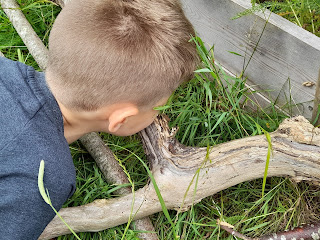STEM
Although our Forest School doesn't deliver 'lessons' or refer to the National Curriculum when planning, it will always overlap.
The Basecamp at the Copse is very much a resource area, where children have access to information and equipment to help them look for, find, and identify the flora and fauna of their environment. It also provides space to try some art in Situ (although this can, and does, happen anywhere), a Book Nook, and a woodwork bench.
On the edges of the Copse are the Mud Kitchen, The Dig Pit, and the Ball Run.
The ball run is the perfect opportunity for observing many skills coming together and provides a practical outlet for science, technology, engineering, and maths.
This week has been a brilliant example.
On Monday the sole session was with a visiting school, and their Year 2 Class helped gather together all sorts of items, old chairs, tyres, an unwanted clothes airer, logs, and a pallet, to ensure the gutter offcuts we have had support on different levels. Some experimenting later they found getting the ball to roll UP-hill was difficult, but if they adjusted the slope and the speed of the ball then they could get the tennis ball to fly up the gutter and plop off the end!
None of this involved writing anything down. The trial and error, the communication between those involved, and the embracing of new ideas led to success.
On Tuesday our Key Stage 1 had sessions at the Copse, and they saw the set up left behind and adapted it. Year 1 preferred to focus on how many slopes they had, how high they could make it, and how far the ball would go when it reached the bottom (which isn't far on grass). They soon found there was a point where the slope made the ball bounce...
Year 2 saw the slopes when they arrived, chose the longest chute (gutter) then moved the rest to create a long race track for the ball to follow once it had sped down the slope. The ball struggled to reach the end, so slowly they realised if they started with a steep drop, but still sloped the racetrack in descending order they could get the ball to the end.
Wednesday EYFS took up the challenge. I showed them how our half tyres roll the ball around to change direction. They busily set up various slopes, each with a half tyre at the bottom, and took great enjoyment from getting it to turn back on itself. They even tried to set another gutter along the bottom to make it turn immediately left or right... and spent quite a while discussing why the ball just jumped out!
That afternoon Year 6 rearranged it all to ensure the ball spun around half a tyre and followed a new track back to the start. At some point someone decided to prop the half-tyre on end, then they experimented with angles that got the ball fast enough to fly out of the tyre and loop-the-loop. Once this was achieved they wanted to find a way to catch the ball onto a different track. This proved to be really tricky!
They soon realised that the placement of the capture gutter needed adjusting depending on the ball used and the speed it was coming. Different people propelled it at different speeds. One ball was bald rubber, two were green fluffy tennis balls (but one was wet), a fourth was slightly bigger.
Once they had the chosen ball and bowler, they tried and tried and tried again
Literally, their last run before we called all back to basecamp resulted in success and a lot of cheering!
Thursday dawned with Year 3 looking at the setup left by Year 6, only now it was windy and the gutters rocked. However, the challenge was accepted!
After much trial and error, and learning by repeating many of the mistakes made by others this week, plus compensating for the wind, they place the gutter so it not only caught the ball, but it created a path back to the start!
My role has been to explain what others have been doing, to offer language like 'angle' and 'acceleration' to give vocabulary to their discoveries, and to provide the time and space to either dip in and out of being on the building team, or to focus entirely.
The physics, engineering, and maths they have been calculating in their heads and hands have been impressive. Along with communication, cooperation, and teamwork.
None of this is in a maths book, science folder, or topic workbook!
But it happened. They have experienced this. They brought prior knowledge, "It won't go up because of gravity", and learned new terms, "Just how many factors are there!?".
Phrases like 'doing a 180' suddenly had a demonstrable meaning!
It will also offer a lot of fun!









Comments
Post a Comment